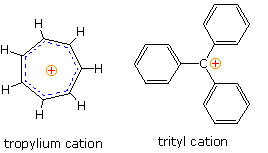
Factors Influencing Carbocation Stability
 المؤلف:
William Reusch
المؤلف:
William Reusch
 المصدر:
Virtual Textbook of Organic Chemistry
المصدر:
Virtual Textbook of Organic Chemistry
 الجزء والصفحة:
............
الجزء والصفحة:
............
 20-7-2018
20-7-2018
 2807
2807
Factors Influencing Carbocation Stability
Carbocation intermediates, sometimes called carbonium ions, have been proposed or identified as important species in reactions ranging from electrophilic addition to alkenes, to unimolecular solvolysis of alkyl halides. The relative stability of these cationic intermediates varies markedly with the presence of substituents on the trivalent charged carbon atom, in a fashion that has led useful empirical rules for predicting reaction selectivity (summarized elsewhere). This stability order for simple alkyl alkenyl and aryl substituted carbocations is repeated below, followed by a table of supportive data.
|
Carbocation
Stability
|
CH3(+)
|
<
|
CH3CH2(+)
|
<
|
(CH3)2CH(+)
|
≈
|
CH2=CH-CH2(+)
|
<
|
C6H5CH2(+)
|
≈
|
(CH3)3C(+)
|
|
|
Carbocation Stabilities Relative to the Ethyl Cation & Tosylate Solvolysis Rates
|
|
Cation
|
Relative
Stability
|
Tosylate Derivative
|
Relative Rate of
Solvolysis in CF3CO2H
|
|
CH3CH2 (+)
|
0 kcal/mole
|
CH3CH2OTs
|
1.0
|
|
CH3CH2CH2 (+)
|
6
|
CH3CH2CH2OTs
|
5.3
|
|
(CH3)2CH (+)
|
22
|
(CH3)2CHOTs
|
2.6 * 104
|
|
(CH3)3C (+)
|
40
|
(CH3)3COTs
|
6.3 * 1013
|
|
A few carbocations, such as tropylium and trityl (triphenylcarbenium) shown on the right, are sufficiently stable to form isolable salts with poorly nucleophilic anions, such as tetrafluoroborate (BF4(–) ). However, most carbocations are unstable and very reactive under normal laboratory conditions, so conventional studies of all but the most stable of these species have not been possible.

Nevertheless, gas phase ionization energies of alkyl chlorides, hydride affinity measurements (gas phase), molecular orbital calculations, and low temperature nmr examination of ionized alkyl halides in mixed solvents composed of SbF5, SO2, SO2F2 & SO2FCl. (referred to as "super acids") have confirmed the qualitative relationship shown above. At low temperatures, 1H and 13C nmr spectra of (CH3)3C(+) and (CH3)2CH(+) were obtained and interpreted. The charged tricoordinate carbon atom exhibited a 13C signal over 300ppm downfield from TMS.
 الاكثر قراءة في مواضيع عامة في الكيمياء العضوية
الاكثر قراءة في مواضيع عامة في الكيمياء العضوية
 اخر الاخبار
اخر الاخبار
اخبار العتبة العباسية المقدسة


